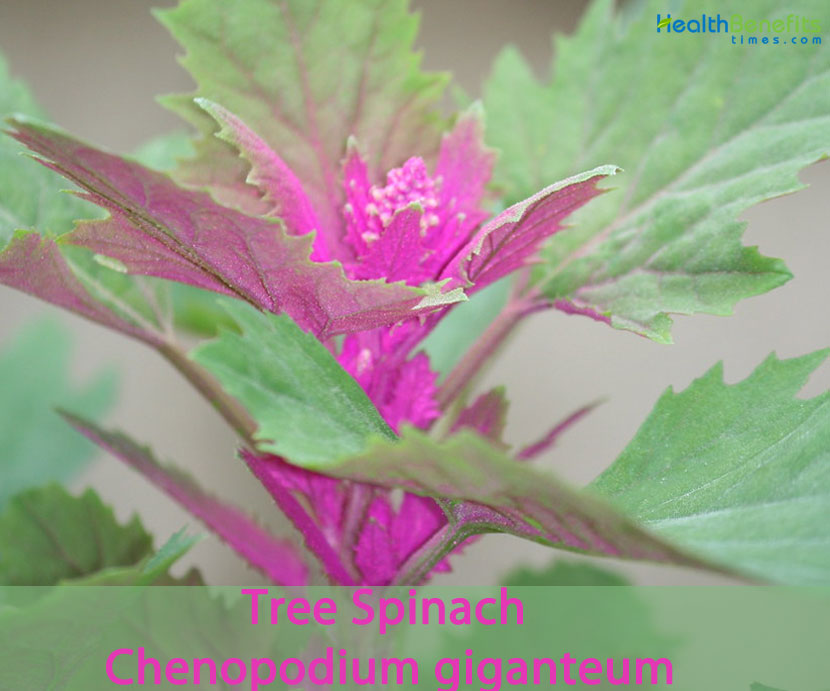It is a leafy green which tastes like very much like chard or spinach with a hint of asparagus when cooked. The best-tasting parts of the plant are the tender growing tips, which can be harvested continuously. Since the plant contains oxalic acid, it should be cooked in a steel pan, not in aluminum. This plant has edible seeds which can be cooked or ground into flour. The plant contains vitamins A, C, and K, and calcium, iron, phosphorus, and potassium. The plant grows well in full sun or partial shade. It is resistant to many pests and is easy to grow.
Tree Spinach Facts
| Tree Spinach Quick Facts | |
|---|---|
| Name: | Tree Spinach |
| Scientific Name: | Chenopodium giganteum |
| Origin | Mountainous regions of India |
| Shapes | Fruits that have seeds of about 1.5 mm in diameter |
| Taste | Tastes very much like chard or spinach with a hint of asparagus when cooked |
| Name | Tree Spinach |
|---|---|
| Scientific Name | Chenopodium giganteum |
| Native | Mountainous regions of India, it is easily cultivated in the UK and other areas |
| Common Names | Magenta Spreen, Purple Goosefoot, Giant Lambsquarters, Spinach tree, Tree Spinach, Tree Spinnach, Bengal cane, large lambsquarters |
| Name in Other Languages | Bengali : Bathua, Lal bathua Chinese: Zhang li (杖藜) Danish: Kæmpe-gåsefod Dutch: Boomspinazie English: Spinach tree, Tree Spinach, Magentaspreen, Tree Spinnach, Bengal cane, giant lambsquarters, large lambsquarters, purple goosefoot Finnish: Jättisavikka French: Ansérine amarante, chénopode couleur amarante, chénopode géant German: Spinatbaum, Großer Gänsefuß, Baumspinat Hindi : Boro bothua, Chilli Hungarian: Oriás libatop Italian: farinello color amaranto Japanese: Supenacchi turii (スピナッチ・トゥ リー), akaza (アカザ) Korean: Myeong a ju (명아주) Norwegian: Kjempemelde Polish: Komosa olbrzymia Russian: Mar’ gigantskaya (Марь гигантская) Sanskrit : Vastukah, Chillikah, Palash lohita Spanish: Cenizo gigante Swedish: Praktmålla, Jättemålla Welsh: Troed-yr-Ŵydd Mawr |
| Plant Growth Habit | Annual, upright many-branched shrub |
| Growing Climates | Weed infested places |
| Plant Size | Up to 3 m. tall and stem diameter of up to 5 cm at the base |
| Stem | Erect, much branched above, stout, reddish green or reddish purple striped, ribbed, base up to 5 cm in diam |
| Leaf | Leaf blade is light green below and dark green above, rhombic to ovate, up to 20 cm long and 16 cm wide, one-half or twice as long as leaf-stalk, below powdery or becoming hairless |
| Flowering season | July to September |
| Flower | The inflorescence consists of terminal panicles with hermaphrodite (both male and female) flowers, which are pollinated by the wind |
| Fruit Shape & Size | Fruits have seeds of about 1.5 mm in diameter |
| Taste | Tastes very much like chard or spinach with a hint of asparagus when cooked |
| Season | August to October |
Plant Description
Tree Spinach is a large, annual, upright many-branched, leafy shrub that grows to a height of up to 3 m with a stem diameter of up to 5 cm at the base. Stem is erect, much branched above, stout, reddish green or reddish purple striped, ribbed, base up to 5 cm in diam. The plant is found growing in weed infested places. It grows well in Mediterranean environment but needs full or partial shade. Chenopodium giganteum does not have high requirements on soil quality. Furthermore, it shows weedy characteristics such as fast growth and rapid spreading.
Leaves
The younger leaves of Chenopodium giganteum are hairy with a magenta color and the older become green. Leaf blade is light green below and dark green above, rhombic to ovate, up to 20 cm long and 16 cm wide, one-half or twice as long as leaf-stalk, below powdery or becoming hairless, above not powdery, base broadly wedge-shaped, margin is irregularly wavy saw toothed. Tip is usually blunt; upper leaf blades gradually becoming smaller, ovate to ovate-lance shaped, reddish or golden yellow vesicular hairy when young, margin saw toothed or entire.
Flower
The inflorescence consists of terminal panicles with hermaphrodite (both male and female) flowers, which are pollinated by the wind. The flowers contain 5 perianth leaves and 5 stamens. Tepals are 5, green or dark purple, ovate, margin membranous. Stamens are 5. Utricle is lenticular and pericarp membranous. The flowering period starts in mid-summer; from July to September.
Fruits
Fertile flowers are followed by the fruits that have seeds of about 1.5 mm in diameter.
Culinary uses of Tree Spinach
- Leaves can be consumed after being cooked.
- Leaves are a spinach substitute.
- The raw leaves should only be eaten in small quantities.
- The seeds can be cooked or ground into a powder and mixed with wheat and other cereals to make bread.
- The seed is small and fiddly; it should be soaked in water overnight and thoroughly rinsed before it is used in order to remove any saponins.
- The young shoots and tender leaves are cooked and eaten like spinach.
Other Facts
- Gold/green dyes can be obtained from the whole plant.
- Due to the partially pink colored leaves, Chenopodium giganteum also has an ornamental value.
- The stems were used traditionally to make walking sticks.
Precautions
- People with a tendency to rheumatism, arthritis, gout, kidney stones or hyperacidity should take especial caution if including this plant in their diet since it can aggravate their condition.
References:
https://pfaf.org/User/Plant.aspx?LatinName=Chenopodium+giganteum
https://en.wikipedia.org/wiki/Chenopodium_giganteum
https://www.itis.gov/servlet/SingleRpt/SingleRpt?search_topic=TSN&search_value=20608#null
https://npgsweb.ars-grin.gov/gringlobal/taxon/taxonomydetail?id=311134
http://www.theplantlist.org/tpl/record/kew-2717345
http://www.flowersofindia.net/catalog/slides/Purple%20Goosefoot.html
https://gd.eppo.int/taxon/CHEGI
https://www.cabi.org/isc/datasheet/12649
https://inaturalist.nz/taxa/208769-Chenopodium-giganteum
https://davesgarden.com/guides/pf/go/51557/#b
Comments
comments
